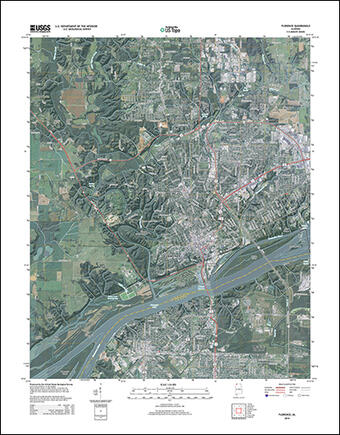National Geospatial Technical Operations Center (NGTOC)
Explore Historical USGS Topographic Maps
The Historical Topographic Map Collection contains USGS topographic maps published from 1884 to 2006
National Geospatial Technical Operations Center
The U.S. Geological Survey National Geospatial Technical Operations Center (NGTOC), under the National Geospatial Directorate (NGD), provides leadership and world-class technical expertise in the acquisition and management of trusted geospatial data, services and map products for the Nation. The NGTOC supports a variety of topographic mapping products and services that constitute The National Map.
Who we are
The NGTOC, along with the Earth Resources Observation and Science Center (EROS), comprises the US Geological Survey’s National Geospatial Directorate (NGD).
The NGD provides trusted geospatial products, services, and science for the Nation and is closely aligned with the missions of the NGP under the umbrella of the Core Science Systems Mission Area of the USGS.
Created by an act of Congress in 1879, the USGS provides science for a changing world, which reflects and responds to society’s continuously evolving needs. As the science arm of the Department of the Interior, the USGS brings an array of earth, water, biological, and mapping data and expertise to bear in support of decision-making on environmental, resource, and public safety issues.
What we do
In 1889, Congress first made annual appropriations to the USGS for topographic mapping. The NGTOC continues that work today.
The NGTOC provides leadership and world-class technical expertise in the acquisition and management of trusted geospatial data, services, and map products for the Nation. It is responsible for the implementation of national geospatial projects including the 3D Elevation Program (3DEP), the 3D Hydrography Program (3DHP), and a variety of topographic mapping products and services which constitute The National Map.
Geospatial research is conducted by geospatial scientists in the Center of Excellence for Geospatial Information Science (CEGIS).
Simply put, we are "the map people." We gather official data to make official federal maps free for public use.
Why it matters
The USGS works with many partners to provide objective and impartial science to resource managers, emergency responders, and the public. Our products and data are necessary to understand, monitor, and detect changes that affect the Nation’s natural and agricultural resources, the economy, public safety, and security.
A glimpse into the past
Although the historical maps may not show the current landscape, they are often useful to scientists, historians, environmentalists, genealogists, and many others as a snapshot of the nation's physical and cultural features at a particular time. A series of maps of the same area may show how it looked as early as the 1880s and provide a detailed view of changes in that area over time.
Scaled paper topographic maps
Did you ever hunt, fish, hike, bike, or cross-country ski using a paper topographic "quad" map for guidance? Chances are it was USGS 7.5-minute (1:24,000 scale) topographic map series produced and printed by the USGS since 1947.
These maps showed latitude and longitude lines, roads, railroads, tunnels, and mines. They showed federal land boundaries, telephone lines, pipelines, and land surveys. They showed vegetation types, water bodies, coastal features, and contours. They showed cities, towns, buildings, schools, picnic areas, campgrounds, and cemeteries.
All of this (and more!) was available to the public for use.
US Topo: Maps for America
Launched in 2009, US Topos combine the familiar look and feel of legacy paper USGS topographic maps with technological advances of the 21st century. US Topo maps offer consistent and complete coverage of the Nation, including Hawaii, Puerto Rico, the U.S. Virgin Islands, and Alaska (completed 2021).
US Topos are refreshed using GIS data from The National Map and published as free geospatial PDF documents. Please visit US Topo: Maps for America for full details.
OnDemand Topos from topoBuilder
With the release of topoBuilder in early 2022, a third variety of USGS topographic map was born. This public application enables users to build USGS-style topographic maps with customizations such as choice of format, area of interest, and National Map content. These next-generation maps, known as OnDemand Topos, are produced upon request using the best available data from The National Map. Learn more at the topoBuilder landing page.


















